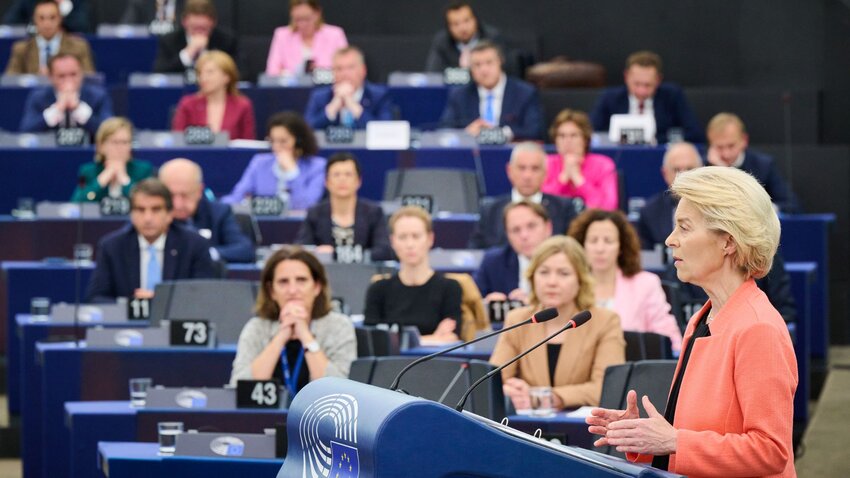In the (almost) never-ending match over tariffs between the United States and the European Union, the world’s attention is now fixed on Friday the 1st of August: a "hard" deadline to reach an agreement, as US Commerce Secretary Howard Lutnick put it, ruling out any further extensions (though he later added that nothing would prevent further dialogue after that date).
In Brussels and the surrounding area, intensive work is therefore being done to put a stop to this roller coaster: if the negotiations fail, the US will immediately impose 30% levies on products arriving from Europe. It’s a constantly evolving situation, and several scenarios are being prepared for.
10% deal falls through
What derailed the agreement in the last few weeks was the United States, which raised the stakes, just as a deal was being reached on an increase in European purchases of US energy and semiconductors in exchange for a 10% cap on tariffs for most goods. A quota equal to that agreed with the UK, plus the fact that sectoral exemptions still remained to be negotiated. Now, even if the 30% scenario is avoided, tariffs are expected to be set at 15–20%, according to the Financial Times. At the same time, hopes appear to be fading for a reduction in existing tariffs on cars (25%) and on steel and aluminium (50%). US tariffs could also be extended to currently exempted categories: pharmaceuticals, critical minerals, semiconductors, timber, aircraft, and shipbuilding.
The strategy of the EU countries
Washington’s increased demand has rattled the European Union, prompting Germany, traditionally the more conciliatory voice, to consider France's tougher approach. While the majority of member states still favour dialogue, there is a growing chorus asking the European Commission to prepare a package of retaliatory measures, not limited to tariffs but also targeting US companies. Specifically, there are thoughts about activating the anti-coercion instrument, which was introduced in 2023 to respond to economic aggression and unfair trade practices by non-European powers: a series of punitive economic measures (such as tariffs, boycotts, or customs controls) designed to force the counterpart to change its decisions.
- You may also be interested in: CSRD directive, what changes after the EU's omnibus package revisions: what's new
In this context, possible targets could include the digital services of US Big Tech firms, restricted access to the financial services and public procurement markets, and limits on the sale of American chemical or food products in Europe. Estimates suggest that an initial package of counter-tariffs, shelved since April, could be worth nearly 21 billion euros and would impact iconic brands and goods such as Harley-Davidson, Levi’s, peanut butter, corn, and soy. A second package could extend to tariffs on tech and automotive, potentially reaching 72 billion euros.

European Union, 2025
Tariffs and a weak dollar: a "complicated scenario"
Meanwhile, the international markets are watching, maintaining a positive outlook in the face of uncertainty. A key topic is the sharp depreciation of the dollar, especially against the euro (down 13.7% since the start of the year). Coupled with rising tariffs, this would further erode the price competitiveness of European exporters, both in relation to US domestic producers and to other less affected countries. It’s a bleak outlook for exports, consumption, and investment, though some relief comes from the partial comeback in oil prices, subdued inflation, and interest rate cuts across the eurozone.
This is the analysis presented by the Centro Studi Confindustria, which describes the situation as a "complicated scenario" and quantifies the potential impact on Italy. With 30% tariffs on all products and the euro-dollar exchange rate holding steady, Italian exports of goods to the US would fall by around 38 billion, equivalent to 58% of current sales to the US, 6.0% of total exports, and, taking indirect connections into account, 4.0% of the manufacturing output. The net impact on the Italian economy would be considerable, though mitigated by the exporters’ ability to find new markets and compete on “non-price” factors. Overall, Italy’s GDP in 2027 would be 0.8% lower.
<<We cannot speak only of tariffs, but of the cost of the euro and the tariffs. In the face of possible US tariffs at 30%, we have to add the weight of the euro-dollar exchange rate, which costs about 13%: we would thus arrive at 43%. For us, the exchange rate is already a tariff,>> warned Emanuele Orsini, president of Confindustria, while speaking at the Chamber of Deputies at the Nuclear Future conference.
Global consequences
It’s not only the European Union that has reason to worry. According to Confindustria, economic policy uncertainty in the United States has more than doubled under the Trump administration (with the Economic Policy Uncertainty Index surging by 131% in the first half of July 2025 compared to December 2024), and this has fuelled a broader spike in global uncertainty (+86%). These are record levels, even exceeding the peak reached during the pandemic.
And while The Donald continues to proclaim victory, claiming he has revived a <<dead country>> in his first six months in office, the outlook for both him and the United States appears far from promising. A CBS poll reveals that 60% of Americans are against the administration’s choices on tariffs. Indeed, tariffs may yet prove a double-edged sword for the US, pushing prices higher: whether for finished goods, intermediate goods, or raw materials, the effect of tariffs tends to be inflationary.
In the meantime, we will have to observe how the global scenario of geopolitical and economic alliances will be reshaped, with the European Union seeking to improve trade relations with the East, as shown by the visit of the President of the European Council, Antonio Costa, and the President of the Commission, Ursula von der Leyen, first to Tokyo and then to Beijing.
- You may also be interested in: Italy-Middle East: strategic alliances to tackle future challenges
The 1st of August will be a pivotal date not only for the EU, but also for other key US trading partners. Without similar trade deals with Washington, they too face the prospect of tariffs ranging from 25% to 40%. According to many analysts, the worst is yet to come. So far, the impact of the tariffs, currently set at 10% for most countries, with higher rates on cars and steel, has been softened by the strategy of many companies, which have stockpiled goods in advance to mitigate rising costs. The worst is yet to come.
Article written by Emanuele Bompan and Maria Carla Rota
This blog is a joint project by Ecomondo and Renewable Matter
Credits:
- Photo by Dati Bendo: https://audiovisual.ec.europa.eu/en/photo/P-067521~2F00-04
PUBLICATION
25/07/2025















